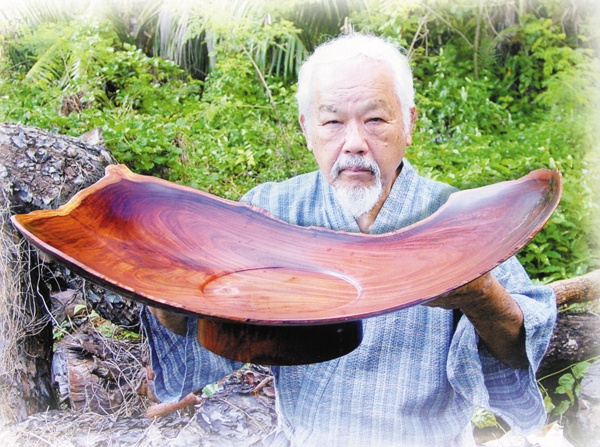LIHUE — Master woodturner Robert Hamada is no stranger to awards and achievements. His list is extensive and well-deserved. But the honor he recently took home was one he had been working toward his entire life. “The governor was there,
LIHUE — Master woodturner Robert Hamada is no stranger to awards and achievements. His list is extensive and well-deserved.
But the honor he recently took home was one he had been working toward his entire life.
“The governor was there, so you know it’s going to be prime,” he said.
The Honpa Hongwanji Mission of Hawaii named Hamada as one of six Living Treasures of Hawaii for 2014. He was honored as a “master artisan of extraordinary fine wood bowls” during the Honpa Hongwanji’s 39th annual award ceremony on Feb. 8 in Honolulu.
While other awardees attended the event strictly for the acknowledgment, Hamada came to also give something back.
“I went there mostly because I wanted to present the bishop with one of my finest bowls, for all the hard work he’s done year after year,” he said.
Carefully cut, turned and sanded from a giant hunk of a milo tree from Molokai, the bowl is brilliant. In fact, Hamada considers it one of his very best.
“This thing is huge,” he said. “Highly polished.”
During the ceremony, standing in front of 500 people, the 92-year-old Wailua resident handed the bowl — if you can even call such a masterpiece a bowl — over to Eric Matsumoto, bishop of the Honpa Hongwanji Mission of Hawaii.
His only advice for the bishop was to handle it like he would a newborn baby. No pressure — the piece was only insured at $100,000. One look, however, and attaching a price to it seems impossible.
“He was speechless,” Hamada said of the bishop. “And I was really shocked because here’s a bishop, a minister, he couldn’t say anything.”
Hamada was born and raised deep in the hills of Kapahi, Kauai and now lives in a rural home in what he calls the “boonies” of Wailua. He previously worked as an engineer at the Coco Palms Resort and Kauai Surf and is also a breeder of some of the finest hunting dogs in Hawaii.
He began turning and working with wood when he was 12 years old. As the decades went by, his work got better.
Today, he has pieces — which can fetch tens of thousands of dollars — on display in some of the country’s top art museums, including the Museum of Fine Arts in Boston, the Detroit Institute of Arts Museum and the High Museum of Art in Atlanta.
In its program write-up, the Honpa Hongwanji Mission said Hamada has achieved the highest level of proficiency in his craft.
“He feels an obligation to turn the largest piece possible from the best part of the wood of a tree and has the uncanny ability to appreciate and work with the wood’s natural scars and flaws in order to enhance the piece,” the program reads. “He is grateful for wood’s imperfections and uses it as a metaphor for life.”
Dr. Margaret Oda, chair of the Living Treasures of Hawaii Committee, said nominees are chosen for their dedicated efforts and contributions to making Hawaii a better place.
Hamada, she said, deserved the award for not only his lifelong dedication to his craft, but for visiting local schools and teaching students about the importance of education, self discipline and hard work.
“We were quite impressed with him,” Oda said. “I think he really represented an outstanding Living Treasure.”
At the ceremony, Hamada and the other Living Treasures were asked to give a short speech.
“It’s very difficult to do that because I’m there for a lifetime accomplishment,” Hamada said. “It took me my entire life, and to speak about it for three minutes, I don’t think it’s sufficient.”
But being somewhat of a loner that he is, often spending hours alone in his workshop, Hamada didn’t mind.
“I don’t like to talk,” he said. “I like to do something.”
More often than not, that something involves a large chunk of rare and beautiful Hawaiian wood. The milo tree is his favorite, but he also works with kou, kauila, kamani and hau.
Most amazing about his works of art is their smooth, shiny appearance. All are unfinished, meaning he uses no wax, lacquer, varnish or oil. Instead, he spends months hand-sanding each piece. His calloused hands tell the story. One piece can take upwards of 10 years from start to finish. And Hamada doesn’t get paid until a piece sells.
But woodworking is his passion. And at 92 years old, he’s still going strong, with 125 bowls in the works, in many different stages of production.
“I’m constantly looking for trees,” he said, adding that all of his bowls are made from trees that had to be cleared for one reason or another, never cut down himself.
Hamada said many people see wood as nothing more than fuel for a fire, unaware of its true value and beauty.
“In many cases it’s right below your nose,” he said of the beauty during a previous interview with The Garden Island. “It’s almost like a woman. You may run into a girl that you see every day and all of a sudden, one day, you see the light. You see the beauty in her. There are other things that makes her beautiful, like her inner thoughts … the things you can’t see from the start.”
• Chris D’Angelo, environmental reporter, can be reached at 245-0441 or cdangelo@thegardenisland.com.


